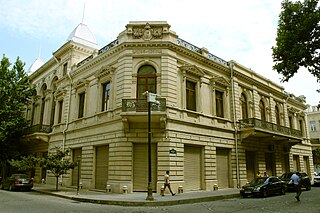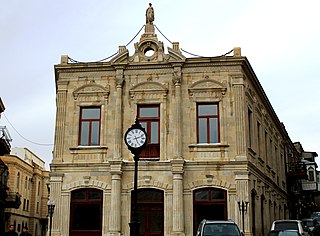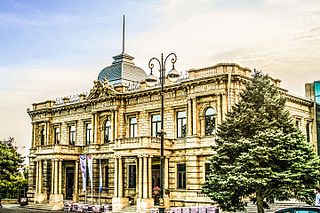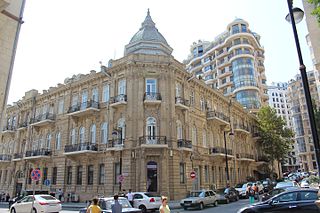
The National Museum of History of Azerbaijan is the largest museum in Azerbaijan. It is located in Baku, in the former residential house of Azerbaijani oil magnate and philanthropist Haji Zeynalabdin Taghiyev. The museum was founded in 1920, following the Russian takeover of Baku, and opened to visitors in 1921.

Juma Mosque, is a mosque in Baku, Azerbaijan.

Nizami Street is a large pedestrian and shopping street in downtown Baku, Azerbaijan, named after classical Persian poet Nizami Ganjavi.

The Ashurbeyovs or Ashurbeylis are an Azerbaijani noble family, with an extensive history and bloodline.

Gilahli Mosque - is a historical mosque located in the city of Sheki, built in the 18th century. The mosque was constructed in 1749 by Sheki Khan Haji Chalabi Khan. In 1805, Haji Shamseddin Bey rebuilt the mosque in the same location. After this reconstruction, the mosque began to be known among the people as the "Haji Shamseddin Bey Mosque".

The Museum of Archaeology and Ethnography is a museum in Baku, Azerbaijan, that was established in 1976. It bears the name of the Azerbaijani architect-Mikayil Huseynov. The museum has two parts. The ethnography section displays materials related to the 19th century and early 20th century, as well as the life of Azerbaijani people.

Palace of Zeynalabdin Taghiyev – Baku, H.Z. Taghiyev Street 4, previously owned by Baku millionaire Zeynalabdin Taghiyev, and now the palace building houses the National Museum of History of Azerbaijan. The building was constructed in 1893–1902 by civil engineer Józef Gosławski. The palace was Taghiyev's gift for his wife Sona khanim. The building covers a whole quarter in the central part of the city and has an ancient planning structure. The main symmetrical facade has been built in the forms of Italian Renaissance. During the construction of the palace, Goslawski used classic order, but some elements of the composition and interiors of the halls were inspired by Azerbaijani architectural traditions. Various architectural styles were used during the construction of the palace.

Tigran Melikov's House is an historic mansion located at the intersection of Islam Safarli and Hazi Aslanov streets in Baku, Azerbaijan. The mansion was built between 1895 and 1897 on the order of Tigran Melikov, a son of the Armenian industrialist Ambarsum Melikov. It is the first building built in the Gothic style in Baku, as well as Józef Gosławski's first project on personal order.

The Building of Baku City Executive Power is an administrative building in Azerbaijan's capital Baku, at Istiglaliyyat Street, 4. The building was built in Baroque style in 1900–1904 on the basis of architect Józef Gosławski's project. The building is the last work of Gosławski. After his death in 1904, the project was initially led by Kazimierz Skórewicz, later by Józef Płoszko.

Palace of De Boure is a palace built by order of Leo De Boure, one of the oil millionaires of Baku in the 19th century and the business manager for Baron Rothschild's company. The palace is located on Niyazi street facing Azerbaijan State Philharmonic Hall. It was built on the project of architect Nicholas von der Nonne in 1891–1895.
The House-Museum of Jalil Mammadguluzadeh is a memorial museum of the famous Azerbaijani journalist, enlightener, writer-satirist, Jalil Mammadguluzadeh. The museum is located on Idris Mammadov Street in the city of Nakhchivan, the capital of the Nakhchivan Autonomous Republic.

The Haji Bani Mosque is one of the mosques of Azerbaijan, was built in the sixteenth century. It is located in Old City, Baku.

The Imam Hussein Mosque or Ashumov Mosque is a historical and architectural monument dating back to the 19th century. It is located in the city of Baku, Azerbaijan.

Mitrofanov Residence is a mansion in Baku, capital of Azerbaijan. It was built by Dmitry D. Mitrofanov, a rich oil baron who employed Johann Edel as the architect for his residence. Construction took place between 1898 and 1902. The building was built in the French Renaissance Revival-style. Following the March 1918 events, the building was used by the Baku Commune. In 1919, during the short-lived Democratic Republic of Azerbaijan, the building housed the French Embassy. With the April 1920 invasion, the building was divided into apartments.

Ashurbeyov House — was an Azerbaijani noble family's mansion built by Teymur bey Ashurbeyov for his younger son Bala bey as a wedding gift. Built in 1904, this mansion is Chief Architect of Baku Józef Gosławski’s final project.

Haji Gulular Palace is a historical and architectural monument located in the city of Shusha. The palace was built in 1849 in the Chukhur mehelle by the order of the merchant of the second guild Gulu Mahammadali oghlu.

Gasimov brothers were the co-owners of the "Gasimov Brothers and Co" construction company, which carried out the construction of most of the buildings in Baku in the late 19th - early 20th centuries. The brothers built such monumental buildings as Ismailia, the Saadat Palace, the New Europe Hotel, and the Mitrofanov Palace. According to Fuad Akhundov, Gasimovs, who built most of the houses of Musa Naghiyev in Baku, carried out the construction work of all buildings raised at that time on the current streets of Istiglalliyyat, and 28 May. In addition, the brothers were involved in charity activity too.

Rylsky brothers' house is a building built in Baku in 1912 on the order of the Polish oilmen the Rylsky brothers. This is an edifice established to the design of Józef Płoszko at 11 Police Street. Currently, the Central Union of Cooperatives of Azerbaijan is located in the building. By the Decree of the Cabinet of Ministers of the Republic of Azerbaijan No. 132 dated with 2 August 2001, the edifice is protected by state and is included in the list of architectural monuments.
Caravansary of Safarov brothers is a caravansary built in Shusha in the 19th century. It is located in Khoja Marjanlı neighborhood. The monument, which belongs to the 19th century, is considered a republican architectural monument of the Republic of Azerbaijan. After the occupation of the city of Shusha by the Armenian armed forces, the building of the caravanserai was destroyed. Currently, its ruins remain.

The House of Shamsi Asadullayev- also known as the Oil Baron's Palace, is a three-story palace-style residential building located in the capital city of Baku, Azerbaijan. It was constructed in 1896 based on the design by architect Johann Edel in response to a commission from Shamsi Asadullayev, one of the millionaires of Baku.


























